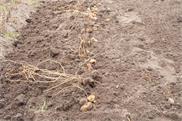1. Картофель широко выращивается в большинстве стран мира.
2. Картофель, являясь ценной пищей для человека, используется также на корм скоту.
3. Промышленное производство картофеля ограничивается районами с довольно прохладным и влажным климатом.
4. Картофель выращивается на различных почвах: суглинках, ступесях торфянистых и других.
5. Картофель убирают механическими копалками.
6. Картофель должен храниться при температуре не выше 40° F.
7. Картофель, как полагают, был привезён в Европу в середине XVI века.
8. Будучи очень важным источником питания для человека, картофель широко возделывается по всему миру.
9. Довольно прохладный и влажный климат больше всего подходит для выращивания картофеля.
10. Соответствующая температура особенно важна в то время, когда картофель образует клубни.
11. Для посева картофель иногда режут на куски, но разрезанные клубни более подвержены болезням.
12. Глубина посева, как известно, зависит от типа почвы.
13. Расстояние внутри и между рядами изменяется в зависимости от плодородия почвы, её влагоёмкости, сорта картофеля и климата.
14. Картофель выкапывается, подбирается и загружается механическими копалками.
15.
 |
Чтобы предотвратить прорастание, картофель хранят в хорошо вентилируемом помещении при температуре 36°-40° F.
Comprehension activities
4. Answer the following questions to text A.
1. How are potatoes used?
2. In what climatic conditions do potatoes grow best?
3. What soils do potatoes require?
4. What are the disadvantages of cutting seed tubers?
5. What affects spacing within and between the rows?
6. How are potatoes harvested?
7. What conditions are necessary for safe potato storage?
5. Read text B without a dictionary. Identify the meaning of the underlined words according to their Russian equivalents and to the context.
Text 18 В
Growing potatoes
Potatoes should be grown in a planned crop rotation to keep the soil fertile, maintain its friable and organic matter content, and reduce crop loss from insects and diseases. The rotations for potatoes depends on the crops grown in the area. It has been found that the highest potato yield and the best quality are obtained when the potato crop follows alfalfa and is planted on the same land only once in six or seven years.
Fertilization of the potato crop varies greatly on different soil types. A green manure crop proceeding potatoes is considered desirable, and animal manure is excellent as a fertilizer. The potato plant responds (реагировать) well to available nitrogen. Complete fertilizer is generally used in commercial potato-producing regions, although sometimes nitrogen may not be necessary on muck soils. Where manure is used, the only additional material needed may be superphosphate.
For many years the most commonly followed method of applying fertilizers has been side dressing. But experiments have shown that the use of one half of the fertilizer applied broadcast before plowing, with the latter half applied in the usual manner gives better results than when all is applied as side dressing.
Weed control is also very import. A number of early-season annual weeds can be controlled by herbicides applied immediately after planting, before the potatoes come up. Where late-season annual weeds are a problem, herbicides may be applied after the last cultivation.
6. Summarize the main idea of text В briefly. Make a summary listing the fertilizers used for potatoes and ways of applying them. What crop should potato follow to produce the highest yield? Why? Complete the task in Russian and in English.
UNIT 19 . ROOT CROPS
| In this unit you will learn: | Grammar focus: - Complex sentences (revision). - Correlative conjunctions (revision). - Conjunctions and their homonyms (words easily confused). Vocabulary focus Reading and comprehension focus: - Text A. Root crops. - Text B. Beets. Listening and speaking focus |
Grammar Focus








